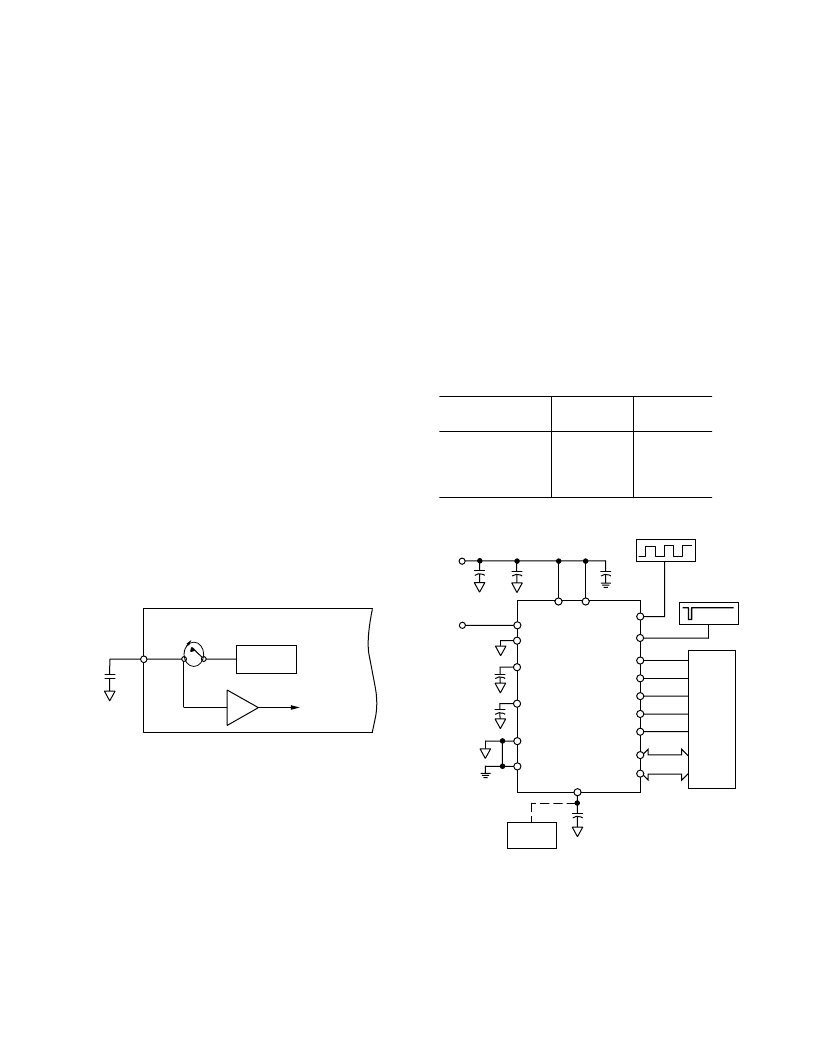- 您現在的位置:買賣IC網 > PDF目錄373920 > AD7854L* (Analog Devices, Inc.) 3.3V/5V Low Power RS232 3-Driver/5-Receiver Transceiver; Package: SSOP; No of Pins: 28; Temperature Range: 0°C to +70°C PDF資料下載
參數資料
| 型號: | AD7854L* |
| 廠商: | Analog Devices, Inc. |
| 英文描述: | 3.3V/5V Low Power RS232 3-Driver/5-Receiver Transceiver; Package: SSOP; No of Pins: 28; Temperature Range: 0°C to +70°C |
| 中文描述: | 3 V至5 V單電源。 200 kSPS的12位采樣ADC |
| 文件頁數: | 18/28頁 |
| 文件大小: | 264K |
第1頁第2頁第3頁第4頁第5頁第6頁第7頁第8頁第9頁第10頁第11頁第12頁第13頁第14頁第15頁第16頁第17頁當前第18頁第19頁第20頁第21頁第22頁第23頁第24頁第25頁第26頁第27頁第28頁

AD7854/AD7854L
–
18
–
REV. B
Using The Internal (On-Chip) Reference
As in the case of an external reference the AD7854/AD7854L can
power up from one of two conditions, power-up after the sup-
plies are connected or power-up from a software power-down.
When using the on-chip reference and powering up when AV
DD
and DV
DD
are first connected, it is recommended that the power-
up calibration mode be disabled as explained above. When using
the on-chip reference, the power-up time is effectively the time
it takes to charge up the external capacitor on the REF
IN
/
REF
OUT
pin. This time is given by the equation:
t
UP
= 9
×
R
×
C
where
R
≈
150K and
C
= external capacitor.
The recommended value of the external capacitor is 100nF;
this gives a power-up time of approximately 135 ms before a
calibration is initiated and normal operation should commence.
When C
REF
is fully charged, the power-up time from a software
power-down reduces to 5
μ
s. This is because an internal switch
opens to provide a high impedance discharge path for the refer-
ence capacitor during power-down
—
see Figure 22. An added
advantage of the low charge leakage from the reference capacitor
during power-down is that even though the reference is being
powered down between conversions, the reference capacitor
holds the reference voltage to within 0.5 LSBs with throughput
rates of 100 samples/second and over with a full power-down
between conversions. A high input impedance op amp like the
AD707 should be used to buffer this reference capacitor if it is
being used externally. Note, if the AD7854/AD7854L is left in
its powered-down state for more than 100 ms, the charge on
C
REF
will start to leak away and the power-up time will increase.
If this longer power-up time is a problem, the user can use a
partial power-down for the last conversion so the reference
remains powered up.
SWITCH OPENS
DURING POWER-DOWN
TO OTHER CIRCUITRY
REF
IN/OUT
EXTERNAL
CAPACITOR
ON-CHIP
REFERENCE
BUF
AD7854/
AD7854L
Figure 22. On-Chip Reference During Power-Down
POWER VS. THROUGHPUT RATE
The main advantage of a full power-down after a conversion is
that it significantly reduces the power consumption of the part
at lower throughput rates. When using this mode of operation,
the AD7854/AD7854L is only powered up for the duration of
the conversion. If the power-up time of the AD7854/AD7854L
is taken to be 5
μ
s and it is assumed that the current during
power-up is 4.5 mA/1.5 mA typ, then power consumption as a
function of throughput can easily be calculated. The AD7854
has a conversion time of 4.6
μ
s with a 4 MHz external clock,
and the AD7854L has a conversion time of 9
μ
s with a 1.8 MHz
clock. This means the AD7854/AD7854L consumes 4.5 mA/
1.5 mA typ for 9.6
μ
s/14
μ
s in every conversion cycle if the parts
are powered down at the end of a conversion. The four graphs,
Figures 24, 25, 26 and 27, show the power consumption of the
AD7854 and AD7854L for V
DD
= 3 V as a function of through-
put. Table VII lists the power consumption for various throughput
rates.
Table VII. Power Consumption vs. Throughput
Power
AD7854
130
μ
W
1.3 mW
2.6 mW
6.48 mW
Power
AD7854L
65
μ
W
650
μ
W
1.25 mW
3.2 mW
Throughput Rate
1 kSPS
10 kSPS
20 kSPS
50 kSPS
4MHz/1.8MHz
OSCILLATOR
AV
DD
DV
DD
AIN(+)
AIN(
–
)
C
REF1
C
REF2
DB11
DB0
CONVST
AGND
DGND
CLKIN
REF
IN
/REF
OUT
AD7854/
AD7854L
ANALOG
SUPPLY
+3V TO +5V
0.1 F
0.1 F
10 F
0.1 F
0.01 F
CONVERSION
START SIGNAL
0.1nF EXTERNAL REFERENCE
0.1 F ON-CHIP REFERENCE
0V TO 2.5V
INPUT
OPTIONAL
EXTERNAL
REFERENCE
CS
RD
WR
BUSY
AD780/
REF192
C/ P
HBEN
FULL POWER-DOWN
AFTER A CONVERSION
PMGT1 = 0
PMGT0 = 1
Figure 23. Typical Low Power Circuit
相關PDF資料 |
PDF描述 |
|---|---|
| AD7854BR | 3 V to 5 V Single Supply, 200 kSPS 12-Bit Sampling ADCs |
| AD7854AR | 3 V to 5 V Single Supply, 200 kSPS 12-Bit Sampling ADCs |
| AD7854L | 12-Bit Sampling ADC(單電源,200kSPS 12位采樣A/D轉換器) |
| AD7854 | 12-Bit Sampling ADC(單電源,200kSPS 12位采樣A/D轉換器) |
| AD7858LARS | 3 V to 5 V Single Supply, 200 kSPS 8-Channel, 12-Bit Sampling ADC |
相關代理商/技術參數 |
參數描述 |
|---|---|
| AD7854LAQ | 制造商:Rochester Electronics LLC 功能描述:12 BIT SINGLE CHANNEL PARALLEL ADC I.C. - Bulk |
| AD7854LAR | 制造商:Analog Devices 功能描述:ADC Single SAR 100ksps 12-bit Parallel 28-Pin SOIC W 制造商:Rochester Electronics LLC 功能描述:12-BIT SINGLE CHANNEL PARALLEL ADC I.C. - Bulk |
| AD7854LAR-REEL | 制造商:Analog Devices 功能描述:ADC Single SAR 100ksps 12-bit Parallel 28-Pin SOIC W T/R 制造商:Analog Devices 功能描述:ADC SGL SAR 100KSPS 12-BIT PARALLEL 28SOIC W - Tape and Reel |
| AD7854LARS | 功能描述:IC ADC 12BIT PARALLEL LP 28-SSOP RoHS:否 類別:集成電路 (IC) >> 數據采集 - 模數轉換器 系列:- 產品培訓模塊:Lead (SnPb) Finish for COTS Obsolescence Mitigation Program 標準包裝:2,500 系列:- 位數:12 采樣率(每秒):3M 數據接口:- 轉換器數目:- 功率耗散(最大):- 電壓電源:- 工作溫度:- 安裝類型:表面貼裝 封裝/外殼:SOT-23-6 供應商設備封裝:SOT-23-6 包裝:帶卷 (TR) 輸入數目和類型:- |
發布緊急采購,3分鐘左右您將得到回復。